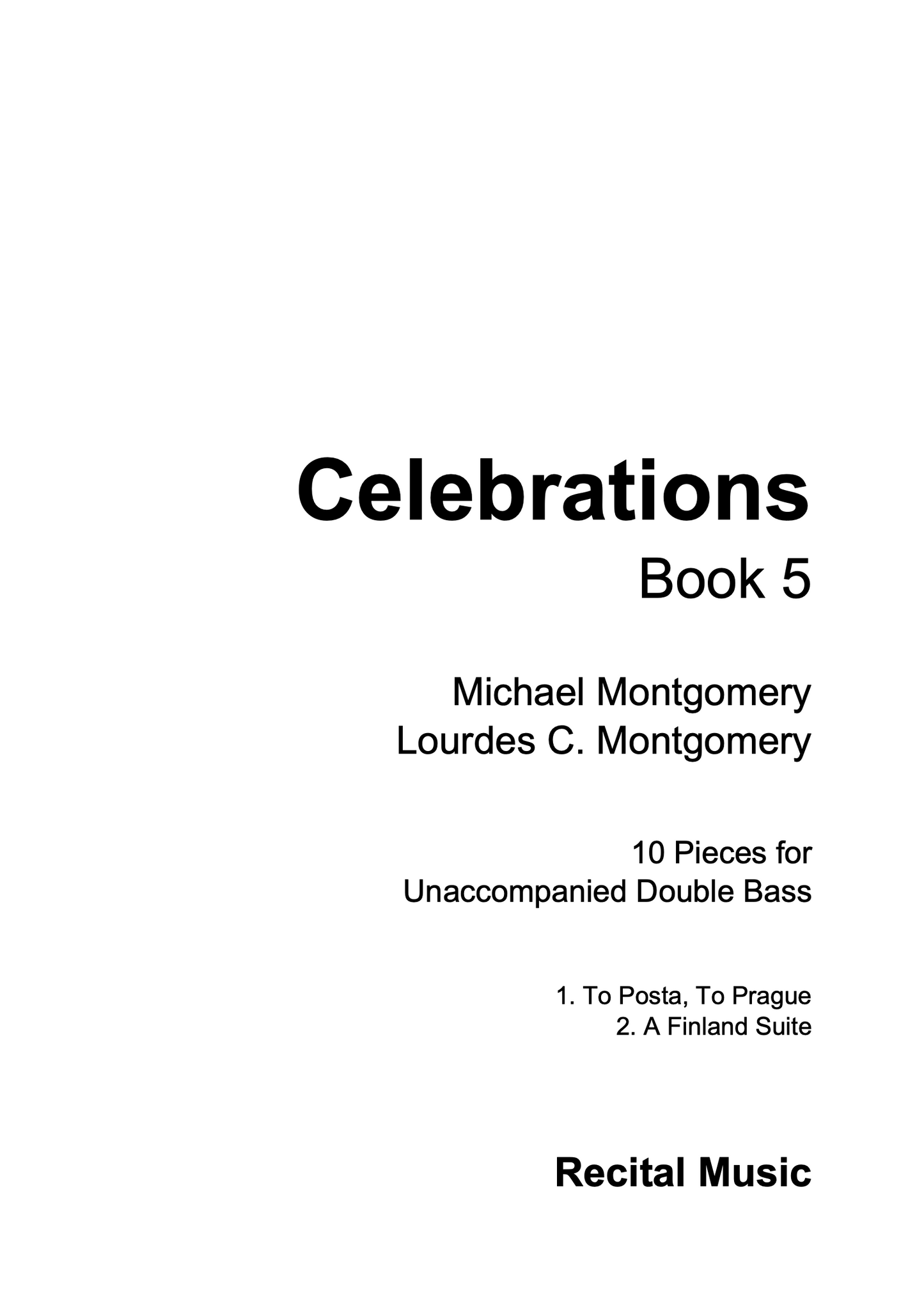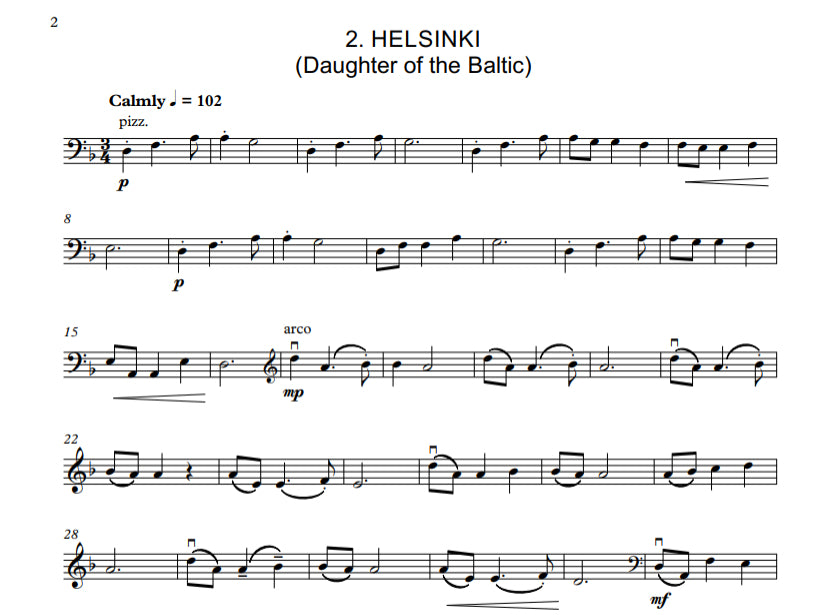David Heyes
Michael & Lourdes Montgomery: Celebrations Book 5 for unaccompanied double bass
Michael & Lourdes Montgomery: Celebrations Book 5 for unaccompanied double bass
Couldn't load pickup availability
About the Composition
Celebrations Book 5 brings together two suites of pieces for unaccompanied double bass by Lourdes and Michael Montgomery. Aimed at the intermediate bassist, these ten inventive, evocative and colorful pieces are ideal as both study and recital repertoire.
Both composers exploit and explore a wealth of colors, textures, and timbres available to the contemporary double bass, always within a lyrical framework, creating music that offers musical and technical challenges in equal measure. The pieces can be successfully performed as a suite or singly, each a perfect miniature soundscape with its own message or story to tell.
Listen and Watch Recordings
Listen to Michael perform these works on his YouTube playlist.
To Pošta, To Prague
1. Guardians of the Legacy
2. Mentors
3. Etude No.5 (Für Pošta)
4. The Sage
5. Today's Youth - Tomorrow's Gatekeepers
This suite was composed in 2017 for Pošta100 to celebrate the anniversary of the 100th birthday of František Pošta in 2019.
Michael Montgomery writes: "I met František Pošta in the early 1980s when I was newly married and still working on my doctorate at the University of Miami under the tutelage of Dr. Lucas Drew. The Czech Philharmonic Orchestra, on tour, had come to town to present a concert at the Dade County Auditorium in the “Little Havana” neighborhood of Miami and Lucas had arranged for the principal bassist of the orchestra to come to his house and give a master class for some of the bass students of his studio. At the time, I was largely unaware of the significance of the position this wonderful bassist held and the great double bass heritage that preceded him in that position.
František Pošta (1919-1991) had studied at the Prague Conservatory from 1934 to 1942, where he was a pupil of Oldřich Sorejs (1891-1953). Sorejs in turn had been a student of František Černý, an important figure in the history of the Prague School of Double Bass. František himself began teaching at the Prague Conservatoire beginning in 1953. He had joined the Czech Philharmonic Orchestra in 1939 and was its principal bassist from 1945 to 1985.
The innovations and study materials of the Prague bassists did not simply stay in Prague; they were, in fact, shared worldwide. For instance, while in Vienna Hungarian bassist Ludwig Manoly studied with Simandl, He later moved to America and in 1892 became the New York Philharmonic’s principal bassist. Manoly’s pupil Herman Reinshagen was the teacher of one Fred Zimmerman (1906-1967). Mr. Zimmerman, assistant principal bass of the New York Philharmonic from 1930-1966, commissioned, transcribed, and edited a prodigious amount of music for his students. He was even the editor of the 1964 Carl Fischer edition of Mr. Simandl’s "New Method". He began teaching at Juilliard in 1935 where he mentored of my own
first teacher, Robert Rohe. Fred’s widow bequeathed Lucas Drew (my second bass teacher) a considerable amount of work which had been left unpublished at the time of his death in 1967. Lucas was able to bring much of the valuable repertory to print. We bassists today have so very much to be grateful for as we consider the legacy passed down to all bassists through the Prague School of Playing. In appreciation of František Pošta's place in that tradition, Lourdes and I humbly offer these several little pieces written for my own young students – it is our hope the legacy will continue to flourish for years to come."
A Finland Suite
A Finland Suite was composed to celebrate the 75th birthday of the legendary Finnish bassist-composer Teppo Hauta-aho (1941-2021).
Program notes Michael Montgomery.
1. Teppo Tiempo - It is hoped the bassist will embrace the abrupt changes of temperament and disposition presented in this short little composition: A somewhat plaintive lament, freely stated in the first eight measures of the piece, quickly gives way to an assertive driving eighth note figure. Bits of this more insistent figure soon combine with fragments of the opening melody to suggest a change of heart, a more adamant disposition. The work closes rather forcefully as an unsympathetic and uncompromising resolution is reached.
2. Helsinki (Daughter of the Baltic) - Helsinki is situated on the Gulf of Finland, 190 miles west of St. Petersburg, Russia. Its residents enjoy mild summers with days of almost 24 hours of sunlight. The city's average high temperature during the month of January, however, is just 29°F, and the total daylight for that entire month averages only 38 hours. It is these long cold and dark winter days that are depicted in this episode.
3. Sveaborg (Helsinki's Fortress on the Sea) - t was the ongoing wars with Russia in the early 1700s that prompted the Swedish parliament in 1747 to build a sea fortress on the Susiluodot islands just off the coast of Helsinki. Spanning six islands, it was renamed Suomenlinna (Castle of Finland) by the Finns in 1918, but the fortress was initially given the name "Sveaborg". An opening motive affirms the confidence of an impregnable fortress, interrupted only briefly by a dolce phrase expressing perhaps the solitude of a lonely night watch before the opening idea returns.
4. The Icebreakers - Each winter much of the Baltic Sea ices over, and the Gulf of Finland itself freezes in late January, rarely thawing before late April. During this time the Port of Helsinki cannot be accessed without the aid of the icebreakers, great vessels whose hulls have been reinforced to smash through frozen waters. Their steadfast, resolute movement forward is here represented by an unrelenting progression of quarter notes.
5. The Baltic Sea - The basin that is today the Baltic Sea was shaped as an ancient river valley was gouged out by glaciers during the last ice age. Its brackish waters are produced as rivers and streams of the surrounding countryside drain into the
Gulf of Finland and Gulf of Bothnia to mix with the salty water of the North East Atlantic. The opening harmonics are meant to recreate an image of icy rain lashing down as it is driven by the winds whipping across the cold, open sea, and the double stops to portray the crashing of the waves.
Born in Havana, Cuba, Lourdes C. Montgomery moved to the United States at age five. She studied jazz piano at Miami-Dade Community College with Sanford Gold and, at the University of Miami, music composition with Dr. Dennis Kam as well as classical piano with Dr. Rosalina Sackstein. Many of Lourdes' sacred and liturgical compositions are published by Oregon Catholic Press, who also produced her CD entitled "De La Cruz a la Gloria", and World Library Publications.
In 2008, Lourdes was honored to have her song Bienaventurados ("The Beatitudes") was performed at the mass of Pope Benedict XVI that was held at the National Stadium in Washington, D.C., and televised nationally. In 2005 Lourdes became music director at St. Vincent de Paul Church in the Ozark Mountains of NW Arkansas, where she now lives with her double bassist husband Michael Montgomery.
About the Composer
Double bassist Michael Montgomery, a student of Robert Rohe (Principal Bass, New Orleans Symphony) and Lucas Drew (Principal Bass, Miami Philharmonic), earned his Doctor of Musical Arts degree in double bass performance from the University of Miami, played full-time in the bass section of the Florida Philharmonic Orchestra for two decades.
He now lives in the Ozark Mountains of Arkansas, where he teaches double bass at the University of Arkansas Fayetteville and privately in his home studio. Michael has composed numerous works for young double bassists (including over five dozen short bass quartets for young students) which are published by Recital Music and two American publishers.
His articles about bass performance, literature, and teaching have been published in American Suzuki Journal, Bass World, and Pastoral Music.









